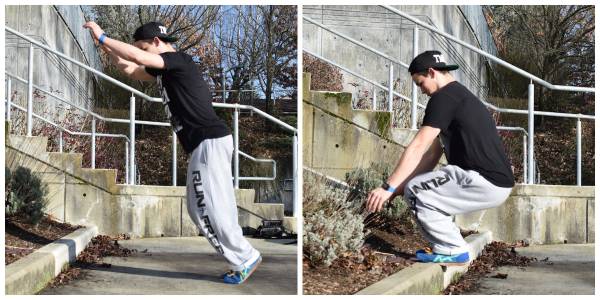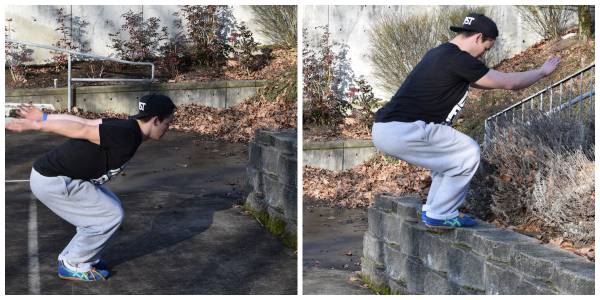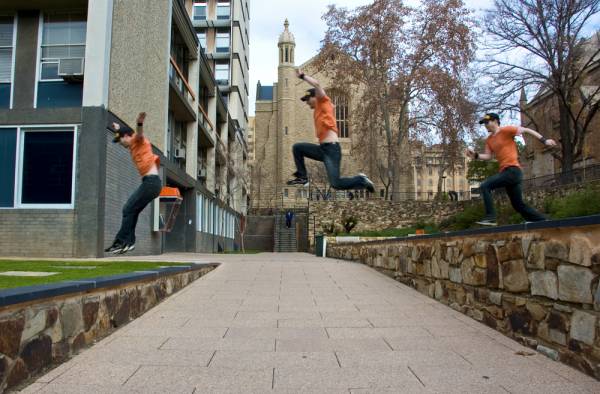“You’re definitely going to hurt yourself.” That’s what my brain kept telling me as I contemplated the jump.
Technically, the jump shouldn’t have been that challenging. I was trying to jump to an upright wooden pillar, about a foot in diameter, only six feet away, and three feet off the ground. Sure, there was a decent gap from the hilltop I was standing on, but it shouldn’t have freaked me out as much as it did.
Fear is a weird thing. I’ve dove into lakes off thirty-foot cliffs and blazed rocky chutes on my snowboard, but trying to jump to that little target had me super nervous. I was mustering up the nerve to huck the jump (injury-be-damned), when my training partner suggested something profound: “Why don’t you try scaling it? It’ll build up your confidence.”
Identifying the Need to Scale
My training partner, Ramman, is an elementary-school teacher, athlete, and adept movement instructor. When he gives you advice about how to move better, you listen. What he was telling me to do is the best piece of advice that anyone new to parkour should understand.
There is always a way to work up to a certain skill. The way to manage your fear and gain the ability to do a scary movement is to figure out how to scale it to your present level.
“When you’re faced with a scary obstacle, seek out a way to get as much support on it as you can.”
In my case, the way I scaled that jump was to start closer and progressively work my way back to the full distance. I was able to successfully land on it from three feet away, four feet away, five feet away, and then 5.5 feet away. The final six inches from 5.5 to six feet was barely noticeable, and definitely not as scary as the first time I looked at it.
I did it! Not a major feat, but certainly a personal victory. Fear conquered.
How Do You Approach Scaling?
When you’re faced with challenges that are freaking you out, pause for a moment, and think about how you might scale the movement to your ability level.
What steps would build your confidence to be able to perform the movement without hesitation? How could you modify the situation to make it less risky? Are there elements of the environment that you could control to boost your success?
Throwing yourself at an obstacle without preparation is a recipe for disaster. By learning to scale skills to your comfort zone, you’ll save yourself a world of hurt.
Five Elements of Scaling a Parkour Skill
1. Distance
Is there a way to master a skill over a shorter distance before working up to a something longer? My story above is a perfect example. Running jumps where you need to clear a gap is another situation. Likewise, bar-to-bar laches where you release one bar to catch another applies here, as well.

The basic idea is that you want to find a similar obstacle that doesn’t have such wide span to cross. Can you find a smaller gap to jump? Could you take off closer to your target and work backward, as I did? Look around your environment to find ways to practice the movement over a shorter distance. With a little creativity you’ll be able to come up with something.
2. Height
There are many times when trying to get onto or over an obstacle can be daunting due to how high it is. Maybe you feel like you don’t have the leg power to vault a chest-high obstacle. Maybe you doubt your upper body strength for climbing an overhead wall.
The solution is to practice on lower obstacles before committing to the full thing. Find a shorter vault to pass and a lower wall to climb, before working your way up. By gaining confidence on shorter features and slowly increasing the height, your brain won’t perceive the obstacle as insurmountable.

3. Speed
Decreasing the speed at which you approach an obstacle gives you a better sense of control and comfort. Beginners learning the step-vault are certainly familiar with this phenomenon. You just watched someone fly over an obstacle with a super fast vault, but now you doubt your chance of success.
“By learning to scale skills to your comfort zone, you’ll save yourself a world of hurt.”
Don’t fret. Slow down. Walk up to the obstacle, place one hand, place your opposite foot, and then step your second leg through. You just did it. Now start to take it faster.
4. Degree of Support
The more limbs on an obstacle, the more support you’ll have, and the safer it will feel. For instance, a step vault is always more stable than a speed vault, given the contact with your foot. If that two-limbed support still seems precarious, you can scale it down by using two hands to get onto the vault before raising your leg.
More limbs equals more stable. When you’re faced with a scary obstacle, seek out a way to get as much support on it as you can.

5. Elevation
Whether cat balancing on a five-foot tall playground structure or striding across elevated girders, operating at height always takes nerves of steel. Rather than succumbing to your fear, build your confidence by performing the skill at ground level.
“Use your brain and take your time.”
If you can cat balance or stride the same obstacle on the floor, why can’t you do it off the ground? Nothing has changed about the effort required. Show yourself that you can achieve success at ground level before attempting any balance challenges at a higher elevation.
Putting It All Together
These five techniques aren’t the only methods to scale a movement, but they will give you a good foundation to build your training. Use your brain and take your time.
Parkour is a lifelong activity – there is no need to rush!
You’ll also enjoy:
- What Is Parkour? Are You Already Doing It?
- Lessons in Parkour: How to Land On Your Feet
- Go Run Up a Wall!
- What’s New on Pulse Beat Fit Today
Photos 1 & 4 courtesy of Shutterstock.
Photos 2 & 3 courtesy of Ben Musholt.






